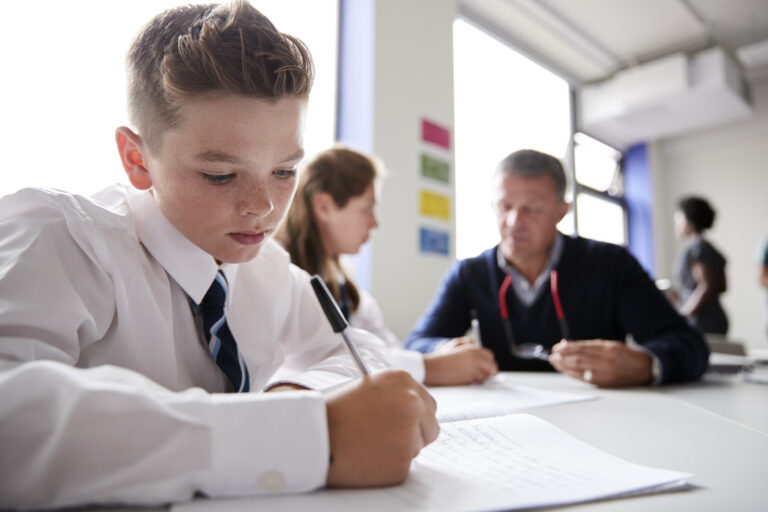In today’s classrooms, educators are faced with a diverse range of students who come from various backgrounds and have different life experiences. Among these students are those who have experienced trauma, which can have a profound impact on their emotional well-being and academic success. As educators, it is our responsibility to create a safe and supportive environment for all students, including those who have experienced trauma.
Understanding Trauma and Its Effects on Students
Trauma can be defined as a deeply distressing or disturbing experience that overwhelms an individual’s ability to cope. It can manifest in various forms, such as physical abuse, neglect, witnessing violence, or experiencing a natural disaster. The effects of trauma on students can be far-reaching, impacting their cognitive, emotional, and social development.
The Importance of a Trauma-Informed Classroom
Creating a trauma-informed classroom is crucial for the well-being and academic success of both students and teachers. By understanding and responding to the needs of traumatized students, educators can provide a supportive and nurturing environment that promotes healing and growth. A trauma-informed classroom not only benefits students but also helps teachers in effectively managing their classrooms and fostering a healthy school environment.
Creating a Safe and Supportive Environment
To create a trauma-informed classroom, it is essential to establish trust and safety for traumatized students. This can be achieved through clear and consistent expectations, creating a calm and predictable environment, and promoting a sense of belonging and acceptance. Additionally, educators can support students in emotional regulation by teaching coping skills and providing opportunities for self-expression. Building positive relationships with students is also crucial in creating a supportive environment.
Implementing Trauma-Informed Teaching Strategies
Trauma-informed teaching strategies can be integrated into the classroom to meet the unique needs of traumatized students. This includes incorporating social and emotional learning into the curriculum, which helps students develop self-awareness, self-management, and social skills. Differentiated instruction and assessments can also be used to accommodate the diverse learning needs of traumatized students. Furthermore, it is essential for teachers to prioritize self-care to prevent burnout and effectively support their students.
Resources for Further Education and Training
Educators can continue to enhance their knowledge and skills in creating a trauma-informed classroom through various resources. Online courses and webinars provide convenient and accessible options for professional development. Books and articles can offer in-depth insights into trauma-informed practices while attending professional development workshops allows for hands-on learning and collaboration with other educators.
In conclusion, creating a trauma-informed classroom is vital for supporting the well-being and academic success of traumatized students. By understanding trauma and its effects, establishing a safe and supportive environment, implementing trauma-informed teaching strategies, and continuing to educate ourselves, we can make a positive difference in the lives of our students.
Understanding Trauma and Its Effects on Students
Trauma can have a profound impact on the lives of students, affecting their emotional well-being, behaviour, and academic performance. In order to create a trauma-informed classroom, it is crucial for educators to have a deep understanding of trauma and its effects. This section will explore the definition and types of trauma, the symptoms that may arise in students who have experienced trauma, and the long-term consequences of unaddressed trauma.
Symptoms of Trauma in Students
- Emotional symptoms: Discuss common emotional symptoms that may be present in students who have experienced trauma, such as anxiety, depression, anger, or withdrawal. Explain how these symptoms may manifest in the classroom and impact a student’s ability to engage in learning.
- Behavioural symptoms: Explore behavioural symptoms that may arise in traumatized students, including acting out, aggression, hyperactivity, or difficulty following rules. Discuss how these behaviours can be a result of the trauma they have experienced.
- Cognitive symptoms: Explain how trauma can impact a student’s cognitive abilities, leading to difficulties with attention, concentration, memory, and problem-solving. Discuss the challenges these cognitive symptoms present in the classroom.
Long-Term Consequences of Unaddressed Trauma
- Academic consequences: Highlight the potential long-term academic consequences of unaddressed trauma, such as poor academic performance, high dropout rates, and difficulty concentrating or participating in class.
- Social and emotional consequences: Discuss the impact of trauma on a student’s social and emotional development, including challenges with forming relationships, low self-esteem, and difficulty regulating emotions. Explain how these consequences can affect a student’s overall well-being.
- Health consequences: Explore the potential physical health consequences associated with unaddressed trauma, such as increased risk of chronic health conditions and compromised immune system functioning.
By understanding the nature of trauma and its effects on students, educators can develop empathy and compassion and implement strategies to support traumatized students in the classroom. This knowledge is essential in creating a trauma-informed classroom that fosters healing, growth, and academic success.
The Importance of a Trauma-Informed Classroom
Creating a trauma-informed classroom is not just an option but a necessity in today’s educational landscape. This section will delve into the importance of establishing a trauma-informed classroom, highlighting the benefits it brings to both students and teachers, as well as its contribution to fostering a healthy school environment.
Benefits to Students
- Enhanced sense of safety: A trauma-informed classroom provides a safe and secure environment for traumatized students, allowing them to feel protected and supported. This sense of safety is essential for their overall well-being and can positively impact their ability to engage in learning.
- Improved academic performance: By addressing the unique needs of traumatized students, a trauma-informed classroom can lead to improved academic performance. When students feel safe and supported, they are more likely to be able to focus, concentrate, and actively participate in their studies.
- Increased emotional well-being: Trauma can significantly impact a student’s emotional well-being. A trauma-informed classroom offers strategies and supports to help students regulate their emotions, develop coping skills, and build resilience. This, in turn, contributes to their emotional well-being and overall mental health.
Benefits to Teachers
- Enhanced classroom management: Understanding trauma and its effects allows teachers to better manage their classrooms. By recognising the underlying causes of certain behaviours and implementing appropriate strategies, teachers can create a calmer and more productive learning environment for all students.
- Increased job satisfaction: When teachers are equipped with the knowledge and tools to support traumatized students, they can experience a greater sense of job satisfaction. Seeing their students thrive and witnessing the positive impact of their efforts can be incredibly rewarding.
- Professional growth and development: Creating a trauma-informed classroom requires ongoing learning and professional development. By expanding their knowledge and skills in trauma-informed practices, teachers can enhance their expertise and contribute to their own professional growth.
Contribution to a Healthy School Environment
- Reduced disciplinary issues: A trauma-informed classroom fosters a positive and supportive environment, which can lead to a decrease in disciplinary issues. By addressing the underlying causes of challenging behaviours and providing appropriate support, students are less likely to engage in disruptive or harmful actions.
- Improved relationships: A trauma-informed approach promotes positive relationships between students and teachers. By demonstrating empathy, understanding, and support, teachers can establish strong connections with their students, fostering a sense of trust and belonging within the school community.
- Cultivation of empathy and compassion: A trauma-informed classroom helps to cultivate empathy and compassion among all members of the school community. By promoting understanding and sensitivity towards students who have experienced trauma it creates a culture of empathy and compassion that extends beyond the classroom walls.
The importance of creating a trauma-informed classroom cannot be overstated. It benefits students by providing a safe and supportive environment, improving academic performance, and enhancing emotional well-being. For teachers, it enhances classroom management, increases job satisfaction, and contributes to professional growth. Moreover, a trauma-informed classroom contributes to a healthy school environment by reducing disciplinary issues, fostering positive relationships, and cultivating empathy and compassion. By prioritizing trauma-informed practices, we can create an educational setting that supports the holistic development and success of all students.
Creating a Safe and Supportive Environment for Traumatised Students
Creating a safe and supportive environment is essential for traumatized students to thrive in the classroom. This section will explore strategies and practices that educators can implement to establish trust and safety, promote emotional regulation, and encourage positive relationships among traumatized students.
Establishing Trust and Safety
- Clear and consistent expectations: Set clear expectations for behaviour and academic performance in the classroom. Consistency helps traumatized students feel secure and understand what is expected of them.
- Predictable routines and structure: Establish predictable routines and structure in the classroom. This provides a sense of safety and reduces anxiety for traumatized students who may struggle with unpredictability.
- Safe physical environment: Ensure that the physical environment of the classroom is safe and conducive to learning. Remove any potential triggers or hazards that may retraumatize or cause distress to students.
Promoting Emotional Regulation
- Teach coping skills: Provide explicit instruction on coping skills that help traumatized students regulate their emotions. This can include deep breathing exercises, mindfulness techniques, or journaling.
- Create a calming space: Designate a quiet and calming area in the classroom where students can go to self-soothe and regain control of their emotions. This space should be equipped with sensory tools and resources.
- Implement self-regulation strategies: Teach students self-regulation strategies such as identifying and labelling emotions, practising self-reflection, and using positive self-talk to manage challenging emotions.
Encouraging Positive Relationships
- Foster a supportive classroom culture: Create a classroom culture that values empathy, respect, and kindness. Encourage students to support and uplift one another, fostering a sense of belonging and acceptance.
- Peer support systems: Implement peer support systems such as buddy systems or small support groups. These structures provide opportunities for students to build positive relationships and provide mutual support.
- Strengthen teacher-student relationships: Develop strong relationships with your students by showing genuine care and interest. Take the time to listen to their concerns, validate their experiences, and provide a safe space for open communication.
By creating a safe and supportive environment for traumatized students, educators can help them feel secure, regulate their emotions, and build positive relationships. These strategies contribute to a trauma-informed classroom that promotes healing, growth, and academic success for all students.
Implementing Trauma-Informed Teaching Strategies
Implementing trauma-informed teaching strategies is crucial in catering to the unique needs of traumatized students. This section will explore various approaches that educators can integrate into their classrooms to create a trauma-informed learning environment.
Integration of Social and Emotional Learning
- Teach self-awareness and self-regulation: Incorporate lessons and activities that promote self-awareness and self-regulation skills. Help students identify and understand their emotions and provide strategies for managing and expressing them in healthy ways.
- Foster social awareness and empathy: Encourage students to develop empathy and understanding for others by teaching social awareness. Promote activities that foster perspective-taking, conflict resolution, and respectful communication.
- Cultivate responsible decision-making: Provide opportunities for students to develop responsible decision-making skills. Teach them to consider the consequences of their actions, make ethical choices, and problem-solve effectively.
Differentiated Instruction and Assessments
- Assess individual needs: Regularly assess the individual needs of traumatized students to better understand their strengths, challenges, and learning styles. This information will guide you in tailoring instruction to meet their specific needs.
- Provide flexible learning options: Offer a variety of learning options to accommodate different learning styles and preferences. Provide opportunities for students to work independently, in small groups, or through hands-on activities.
- Modify assignments and assessments: Modify assignments and assessments to ensure they are accessible and appropriate for traumatized students. Consider alternative forms of assessment that allow for creativity and expression.
Self-Care for Teachers
- Prioritize self-care: Educators must prioritize their own self-care to effectively support traumatized students. Encourage teachers to practice self-care strategies such as exercise, meditation, or engaging in hobbies to manage stress and prevent burnout.
- Seek support and professional development: Provide opportunities for teachers to seek support and professional development in trauma-informed practices. This can include workshops, conferences, or peer collaboration to enhance their knowledge and skills.
By implementing trauma-informed teaching strategies, educators can create an inclusive and supportive learning environment that meets the needs of traumatized students. By integrating social and emotional learning, differentiating instruction and assessments, and prioritizing self-care, teachers can positively impact the academic, emotional, and social growth of their students.
Resources for Further Education and Training
Continuing education and training are vital for educators to deepen their understanding of trauma-informed practices and enhance their ability to create a trauma-informed classroom. This section will explore various resources that educators can utilize for further education and training in this area.
Online Courses and Webinars
- Online courses: Identify reputable online courses that focus on trauma-informed practices in education. These courses provide comprehensive training and knowledge in understanding trauma, implementing strategies, and creating supportive environments.
- Webinars: Attend live or recorded webinars that address specific topics related to trauma-informed practices. These webinars often feature experts in the field and provide insights, strategies, and practical tips for educators.
Books and Articles
- Books on trauma-informed practices: Recommend books that delve into trauma-informed practices in education. These books provide in-depth insights, research, and practical strategies for creating trauma-informed classrooms.
- Articles and research papers: Encourage educators to stay updated with the latest research and best practices in trauma-informed education. They can explore academic journals, education publications, and research databases to access relevant articles and research papers.
Professional Development Workshops
- Workshops and conferences: Inform educators about professional development workshops and conferences focused on trauma-informed practices. These events provide opportunities for networking, learning from experts, and engaging in hands-on activities to enhance their knowledge and skills.
By utilising these resources for further education and training, educators can continually enhance their knowledge and skills in creating trauma-informed classrooms. By staying informed, engaging in professional development, and seeking out relevant resources, educators can make a meaningful and lasting impact on the lives of traumatized students.
Related posts:
 Why Points Systems in Schools Might Not Work, or Worse, May Even Be Damaging
Why Points Systems in Schools Might Not Work, or Worse, May Even Be Damaging
 Empowering Students’ Voices: Promoting Agency and Resilience in Trauma-Informed Classrooms
Empowering Students’ Voices: Promoting Agency and Resilience in Trauma-Informed Classrooms
 Promoting Self-Care for Teachers: Supporting Wellbeing in Trauma-Informed Classrooms
Promoting Self-Care for Teachers: Supporting Wellbeing in Trauma-Informed Classrooms
 A Teacher’s Guide to Trauma-Informed Classrooms
A Teacher’s Guide to Trauma-Informed Classrooms



